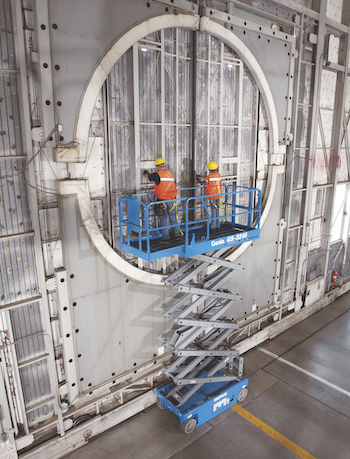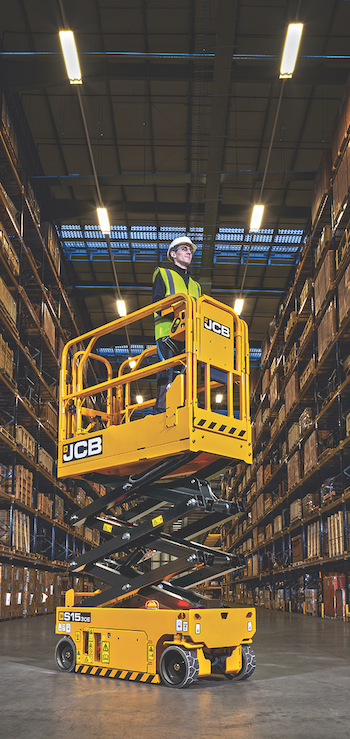Industry outlook -- Scissor lifts
Demand grows as users strive for safer, more productive job sites.
Increasingly, job site bosses and workers are choosing scissor lifts over ladders and scaffolds. Users appreciate the more comfortable and safer work platforms, and it’s increasing unit rentals and sales.
Industry experts share their views on scissor lift opportunities and how rental centers can leverage them.
Kristopher Schmidt
Product Manager, Skyjack
Versatility benefits
Scissor lifts are experiencing extreme growth and performed strongly throughout Q2 2018. The most predominant are rough-terrain DC electric scissor lift models in the 18- to 20-foot and 30- to 35-foot range.
Rental houses can leverage technology such as Skyjack’s Elevate telematics solution to track machine usage, manage batteries and flag service needs.
Scissor lifts are versatile pieces of equipment so contractors tend to keep these machines on site longer. Aftermarket products, such as Skyjack’s Accessoryzers, can increase the many ways job sites can use scissor lifts to safely transport personnel
and material to height. Machines that are rated for indoor and outdoor use give the rental center an opportunity to rent out the machine for a larger variety of jobs.
This leads to higher utilization rates and a better ROI. Scissor lifts offer a competitive initial acquisition cost; low operating cost with fast turnaround on repairs, less downtime, cost-effective replacement parts and easily accessible service areas; and increased residual value.
 |
Don Shi
Founder, Forever ODM
Scissor boom lift alternative
With the new ANSI A9.20 standard coming, manufacturers may have to make scissor lifts heavier to withstand the effect of outdoor winds. Many will also have to go to a platform load cell so load-sensing accuracy is not affected by cold weather. Prices will go up with the new ANSI standard.
Forever-ODM is innovating the traditional scissor lift into a scissor-boom lift design where the top platform has a three-section telescoping system that extends up to 15 feet. This allows customers to do jobs previously completed with light boom lifts and will offer rental centers fast ROIC on their investment. A scissor boom lift is half the cost of a boom lift and has much lower maintenance cost.
For end users, the scissor boom lift offers convenience and efficiency. It can be towed on a trailer by a pick-up. It is easy to operate, which means less training and easier to operate.
Most of the rental houses try to recover their scissor lift investment within two years, but this may have to be extended with more costly outdoor units under the ANSI A9.20 standard. Forever-ODM’s patent-pending scissor-boom lifts will recover faster because they can be rented at higher rates than conventional scissor lifts while contractors will be able to rent them for less than boom lifts. It is a win-win situation for the rental house and contractors.
 |
Mike Flanagan
Genie Product Manager, Terex AWP
Models boost productivity, safety and ROIC
This is proving to be a strong year for the North American scissor lift market, with increasing end-user focus on productivity options and accessories. It is driving demand for material-handling attachments such as pipe and panel cradles and tool trays.
Significant growth in high-rise construction has increased the need for lower platform-height machines with lighter floor loading. Rental managers are moving to smaller and more compact lifts.
 |
| Increasingly, scissor lifts and other MEWPs are taking workers to heights instead of ladders. |
With the new ANSI/CSA standards on the horizon, scissor lifts will be re-engineered to meet new requirements. Changes to machine specs are establishing global standards of machine commonality. Load-sensing systems will be the most significant impact to the new ANSI/CSA standards for the North American market.
Technological changes in the aerial work platform industry are ranging from new products that optimize design for maximum end-user productivity to control systems that improve serviceability and drive down total cost of ownership for rental centers.
Rental houses and end users must work together to properly equip job sites with machines that meet the application needs as well as the necessary attachments so jobs can be done in an efficient and safe manner.
A number of metrics need to be considered when evaluating the rental return on invested capital (rROIC) on scissor lifts in a rental fleet. Acquisition cost must be balanced against maintenance costs, rental rate, utilization rate and residual value. Within these costs there are multiple variables; rental rates vary by market, job size and product category. Rental store owners must tailor their model mix to meet the needs of their market in a way that will result in a favorable return across their scissor lift line.
New products and attachments offer the best opportunities for scissor lift rental store owners. Attachments, which are commonplace with equipment such as telehandlers and skid steers, are increasingly popular on boom lifts and scissor lifts.
 |
Kenneth Paul
Marketing Communications/Customer Analytics Manager, Haulotte
Scissor lifts improve job site safety, productivity
The new ANSI/CSA standards expected to be published soon are the biggest influence driving changes today. To that end, Haulotte has worked closely with the industry to develop innovative features that help end users and rental centers. For example, Activ’Screen technology gives users and technicians an in-depth look at machine status including any trouble codes. Diagnosis, programming and repair resolution are faster and easier with Activ’Screen.
Haulotte scissor lifts use asynchronous motors, which result in fewer hydraulic connections and less risk for leaks and easier maintenance. AC motors also provide smoother driving and steering as well as increased torque for climbing slopes and ramps.
Safety is a growing trend in construction. Contractors are combatting injuries from ladder falls by banning ladders entirely from job sites. This means more scissor lifts of all sizes are being used. Rental stores with a good mix of compact scissor lifts that have low floor loading and can fit through small doorways, paired with larger scissors with enough room for tools, materials and multiple workers, will best meet customer demands.
 |
David Langford
Access Product Manager, JCB North America
Scissor lift demand increasing
The increased demand for scissor lifts is consistent with increased rates of building and construction. Scissor lifts are also being deployed in a wider variety of applications and in more diverse environments.
At the time of this growth, the mobile elevated work platform (MEWP) sector is undergoing change. Within 12 months, all new scissor lifts must meet the new American National Standards Institute (ANSI) standard. This requirement will result in a significant reengineering and redesign efforts at some manufacturers. JCB Access electric scissor lifts, however, were designed from their beginning to exceed the new standard, so JCB is well-positioned to continue to meet demand for ANSI-compliant models.
 |
| JCB scissor lifts were designed from the start to meet the coming ANSI standard requirements. |
Due to the new ANSI standard and in part due to a general construction industry trend, technology and automation are increasingly evident in modern MEWPs. For example, ANSI-compliant machines will feature load sensors that alert the operator when the load exceeds 90 percent capacity. Technology is also being deployed on MEWPs to reduce downtime, enhance fleet management, increase utilization and productivity for safer job sites.
JCB scissor lifts can be equipped with JCB’s LiveLink Lite telemetrics technology. It allows owners, fleet managers and operators to use a desktop computer or mobile device to remotely access machine status information such as location and mapping, landmark alerts, curfew alerts, battery backup, tow-away wakeup, machine hours, working time, machine reports, fleet reports and service history. It can help schedule maintenance to reduce downtime and boost utilization.
JCB is pioneering the use of li-ion batteries in scissor lifts and it intends to bring this technology to North America. Li-ion batteries last longer and require less maintenance than conventional lead-acid batteries and will reduce ownership costs over the life of the machine. These batteries can be fully recharged in half the time, which results in higher utilization rates.
Because of the low initial capital expenditure for a JCB electric scissor lift, the return on investment for the rental house is high and achieved quickly. For example, if a JCB 19-foot electric scissor is rented consistently every week, it may make back the purchase cost in eight months or less.
Current growth in the construction sector is driving stronger demand for electric scissor lifts and other mobile elevated work platforms. Regionally, the western United States represents the largest market for electric scissor lifts, with more than 9,600 units sold in the first seven months of 2018.
The fastest growth, however, is coming from the southeast United States, fueled largely by industrial expansion and increased activity in the import/export sector. Approximately 8,600 scissor lifts have been sold in the southeast in 2018, which is about 2,400 more units than at the same time in 2017.
 |
Alan Dotts
Sales Manager - Special Products Toyota Material Handling Co.
Lifts replacing ladders
New safety standards are being developed to make scissor lifts safer and to comply with the new standards, manufacturers will need new designs and technology. The changes will affect renters and operators. Rental houses that spec lifts to match customers’ unique needs will gain business. Scissor lift technology will prevent overloading and misuse, which should help increase uptime and decrease maintenance expenses from misuse. End users will benefit by having safer and properly operating lifts that are matched to their needs. Increased productivity and fewer accidents or injuries will save renters time and money.
ROI is often calculated differently, depending on the rental company. The old-school method takes the acquisition cost and multiply it by 4.5 percent to determine the monthly rental rate. ($15,000 x 4.5% = $675)
A more accounting-based method takes the acquisition cost, then doubles the straight-line depreciation plus maintenance on a 60-month $0 value at term end. ($15,000 asset, 60 month term, 5% into rate = $282/month x 2 = $564 + $100 = $664).
Both methods come to nearly the same amount, but the real key to rental rates is utilization. For example, an indoor lift could have 80 percent utilization while an outdoor lift could have 60 percent. The objective is to obtain your ROI and have two to three years of useful life left in the scissor lift to produce more profit for the company through rentals or sales.
The trend is to use scissor lifts to improve productivity and safety in a variety of applications. From stock picking to food service and general maintenance, scissor lifts are the safest method for working at almost any height. Narrow aisles and taller facilities are demanding more compact designs. Eventually, ladders and rolling ladders will be completely replaced by man lifts.
 |
Justin Kissinger
Vice President of Marketing, Custom Equipment
Smaller units growing in popularity
Safety continues to be a focus, especially when it comes to preventable ladder-related injuries. According to OSHA, falls are the No. 1 cause of death in construction, and they aren’t cheap. Just one worker’s compensation claim can cost tens of thousands of dollars; the U.S. Consumer Product Safety Commission’s estimates $24 billion in annual costs associated with ladder injuries. Scissor lifts are a safe and effective alternative, providing a way for contractors and project owners to minimize risk and liability.
There is also a trend in the scissor lift arena toward low-level access lifts. Lighter weight, low-level lifts combined with a tight turning radius offer a broader range of applications and can work in finished buildings and new construction without worry of damage. Lightweight lifts can be moved in an elevator and operate on delicate surfaces such as green concrete; some lifts are so light they can easily be pushed around by hand and maneuvered easily into any spot.
In a productivity-driven world, it’s important to look at the efficiency of equipment. That’s the main driver of a trend for increased lift capacities. Some smaller scissor lifts offer higher lift capacities than larger models, enabling contractors to carry more supplies than other lifts without overloading the platform. The increased capacity reduces the number of trips up and down to get supplies, increasing efficiency and minimizing worker fatigue.
Industry associations are well into their educational drives to encourage contractors to right-size lifts for the job. Most jobs performed by a 19-foot lift can easily be performed by a lower-level lift, and safety is enhanced in the process. When a lift can extend farther than needed for the job, there is a risk the operator will inadvertently overextend the lift, getting pinched or crushed between the lift and the ceiling or work area. This is driving the demand and development of lower-level lifts.
The versatility of lightweight scissor lifts and demand driven by safety trends provides rental centers with a significant opportunity. The low platform height and tight-turning radius make them ideal for construction and maintenance. Combined with a ladders-last mentality, low-level lifts are valuable to the end user.
Hy-Brid Lifts can get into places other lifts can’t, which enhances profitability and equipment utilization. Navigating narrow hallways and elevators can be impossible with 19-foot lifts. Hy-Brid lifts easily fit in elevators and through standard doorways.
Scissor lifts provide the reach and versatility they need, along with the safety and efficiency they want. We are also seeing increased interest in factories, mills and warehouse facilities where moving a compact lift around is much faster and less fatiguing than using ladders.
 |
Rafael Nuñez
Sr. Product Manager - Scissor and Vertical Lifts, JLG
Two lines fit rental needs
Changes to the American National Standards Institute (ANSI) and the Canadian Standards Association (CSA) for aerial work platforms will affect machine design, safe use and training. Updates to ANSI A92 are expected to be published soon, and the new CSA B354 standard was published in May 2017. Effective one year from their dates of publication, any new aerial machine manufactured in the United States or Canada must meet these new standards. Machines manufactured prior to that date will continue to be governed by existing standards. JLG is committed to meeting and exceeding the new standards.
JLG offers two lines of electric scissor lifts: The popular ES-Series with premium features and an electric-drive system; and the value-driven hydraulic-drive R-Series with an active pothole protection system. Some components, such as lubrication-free scissor arm bushings, can be found in both lines to deliver maximum uptime.
The technologies built into every JLG scissor lift is what sets them apart. For example, JLG’s exclusive variable-tilt technology allows operators to elevate to limited heights when working on slight slopes. Additional technologies included on JLG scissor lifts include:
- Controlled elevation descent, which cushions the ride as the unit stops on its way up or down.
- Controlled-drive descent that protects the machine while on slopes.
- The 4045R, the narrowest machine in its size class, has a pressure-based load-sensing system (LSS) that can be calibrated in the field. LSS is less sensitive to ambient temperatures, especially in cold weather.
- Dual capacity is available on select ES-Series models so end users can take additional materials and tools to lower elevations.
Copyright 2018 Direct Business Media, LLC. All rights reserved.
Left: Custom Equipment’s Hy-brid Lift HB-1430 Electric Scissor Lift is self-propelled with a lightweight design.
Below: JLG scissor lifts have controlled elevation descent, which cushions the ride as the unit stops on its way up or down.








